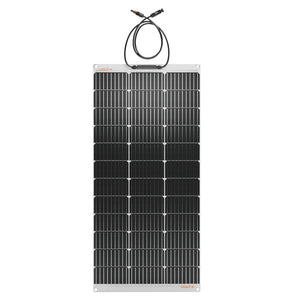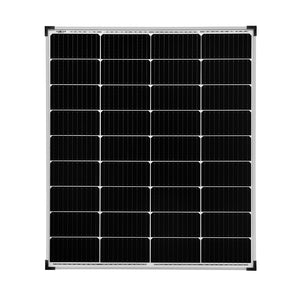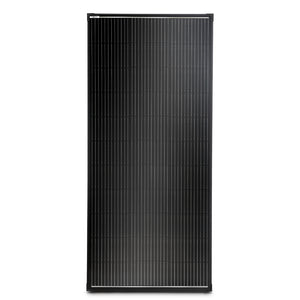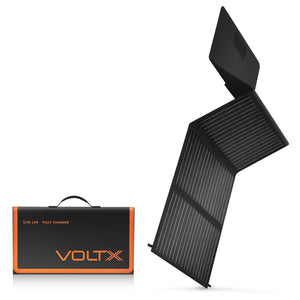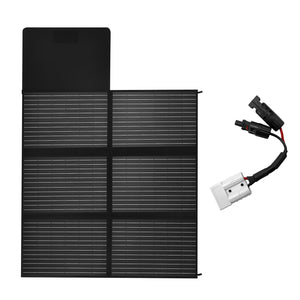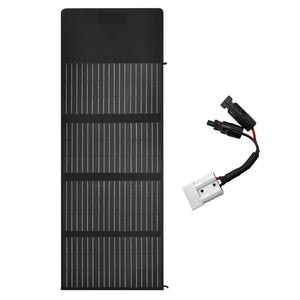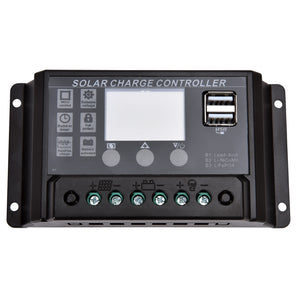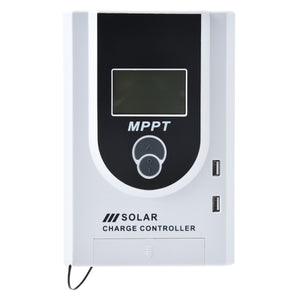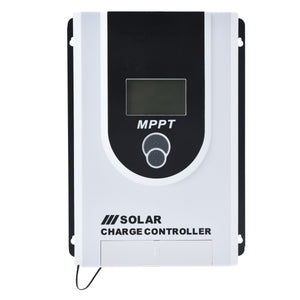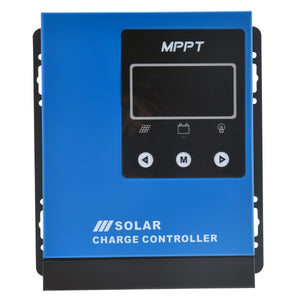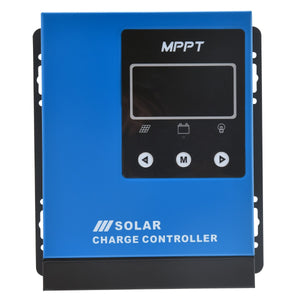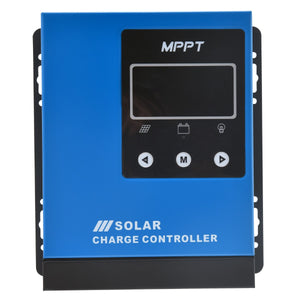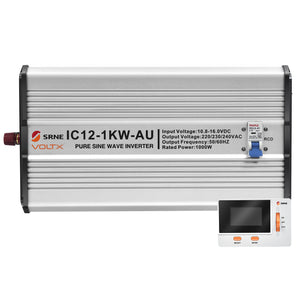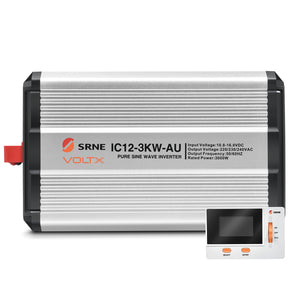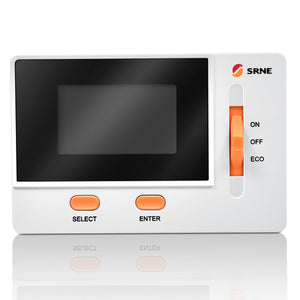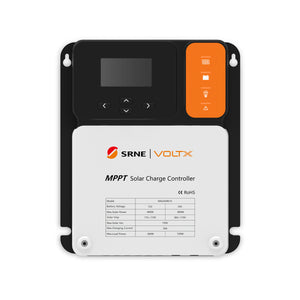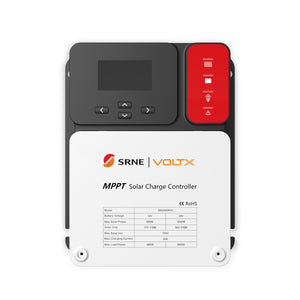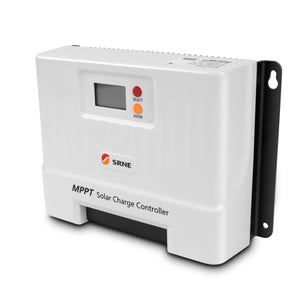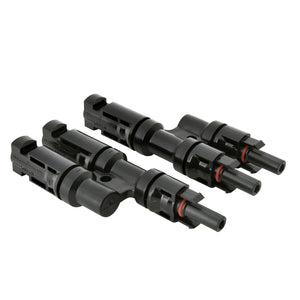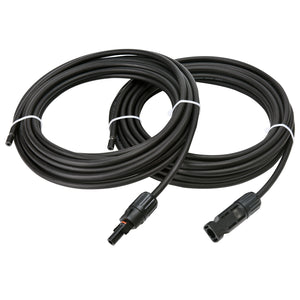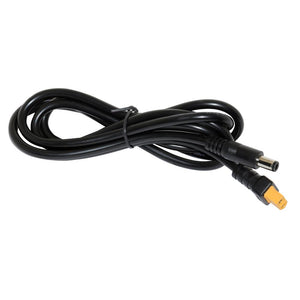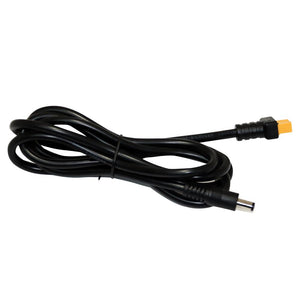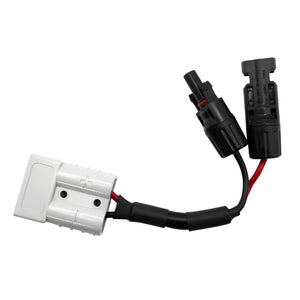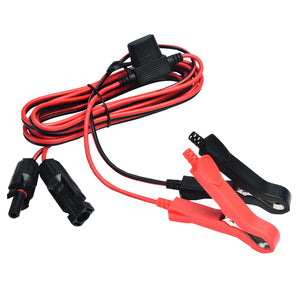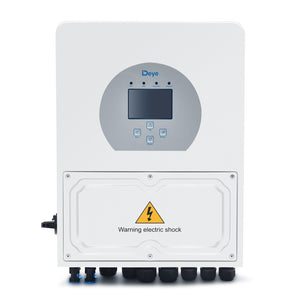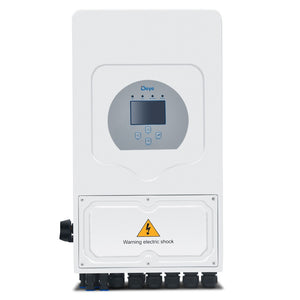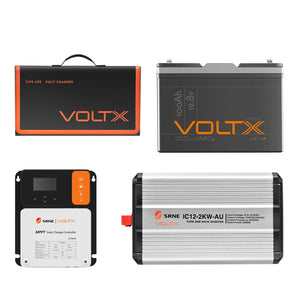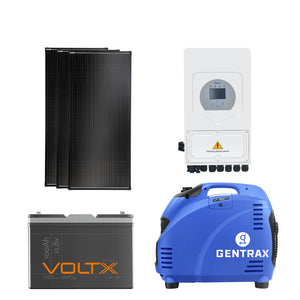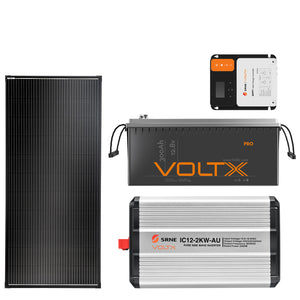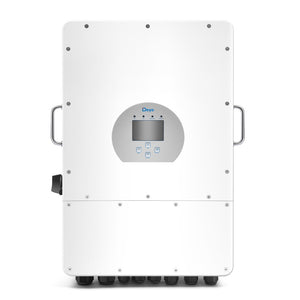VoltX 12V 200W Folding Solar Mat ETFE (Solar Panel Only)
Was$489.00Now $244.50Unit price /UnavailableVoltX 12V 100W Folding Solar Mat ETFE (Solar Panel Only)
Was$289.00Now $173.40Unit price /UnavailableSolar Charge Controller 60A 12V/24V/36V/48V MPPT with Bluetooth
$359.00Unit price /UnavailableLow stockVoltX 12V 1KW Pure Sine Wave Inverter + FREE VoltX Inverter LCD Display
$499.00Unit price /UnavailableVoltX 12V 2KW Pure Sine Wave Inverter + FREE VoltX Inverter LCD Display
$599.00Unit price /UnavailableVoltX 12V 3KW Pure Sine Wave Inverter + FREE VoltX Inverter LCD Display
$869.00Unit price /UnavailableMC4 Connector Plug DC5521 Adapter Copper Core Wire Cable 1.5m
Was$19.90Now $11.94Unit price /UnavailableXT60 Male Female Connector Plug DC6530 Adapter Wire Cable 1.5m
Was$19.90Now $11.94Unit price /UnavailableXT60 Male Female Connector Plug DC5521 Adapter Wire Cable 1.5m
Was$19.90Now $11.94Unit price /UnavailableDeye 48V 5KW Hybrid Solar Inverter MPPT Charger Regulator Low Voltage
$2,199.00Unit price /UnavailableVery low stockDeye 48V 8KW Hybrid Solar Inverter MPPT Charger Regulator Low Voltage
$3,899.00Unit price /UnavailableBUNDLE DEAL - VoltX 12V 100Ah Lithium Battery + 100W Solar Blanket + 2000W Inverter + Controller
$1,529.00Unit price /UnavailableBUNDLE DEAL - VoltX 12V 100AH Lithium Battery + 8KW Inverter + 3* 200W Solar Panel + 3.5KW Generator
$6,029.00Unit price /Unavailable- $2,789.00Unit price /Unavailable
Deye 48V 10KW Hybrid Solar Inverter MPPT Charger Regulator Low Voltage
$6,399.00Unit price /UnavailableVery low stockDeye 48V 6KW Hybrid Solar Inverter MPPT Charger Regulator Low Voltage
$2,499.00Unit price /UnavailableVery low stock
How To Power Your Home With A Solar System
With electricity prices soaring by up to 25% in recent years across Australia, homeowners are increasingly turning to solar power for home use as their pathway to energy independence. The rising cost of living has made sustainable living more than just an environmental choice—it's become a financial necessity for countless households seeking relief from crushing electricity bills. What once seemed like complex technology reserved for eco-warriors has transformed into an accessible solution that everyday Australians are embracing with remarkable success. At Outbax, we've witnessed firsthand how renewable energy adoption has shifted from luxury to necessity, with more families discovering that harnessing the sun's abundant power is far more achievable than they ever imagined. Whether you're motivated by environmental concerns, the desire for energy security during increasingly frequent blackouts, or simply tired of unpredictable utility costs, setting up a home solar system has never been more straightforward or rewarding.
Understanding the Core Components of a Home Solar Setup
Every home solar system relies on four essential components working in harmony to transform sunlight into usable electricity for your household. Solar panels for home use serve as the collectors, capturing sunlight and converting it into DC electricity through photovoltaic cells—with monocrystalline panels like the VoltX 130W Fixed Solar Panel offering superior efficiency rates that maximise energy harvest even in limited roof space. The inverter acts as the system's brain, converting the DC electricity from your panels into AC power that your home appliances can actually use, with advanced hybrid solar inverters like the Deye models managing power flow from panels, batteries, and the grid simultaneously for optimal efficiency.
Battery storage functions as your energy reservoir, with lithium batteries storing excess solar energy generated during sunny periods for use at night or during power outages—the VoltX 100Ah or 300Ah batteries found in bundle deals provide this crucial energy independence that transforms your home into a self-sufficient power station. The solar charge controller serves as the regulator, protecting your battery from overcharging and ensuring longevity, with MPPT and PWM types available, though the sophisticated Deye inverters have this technology built in, streamlining your setup while maintaining peak performance. Together, these components create a reliable solar panel and battery system that delivers consistent, clean power while dramatically reducing your reliance on the traditional electricity grid.
Sizing Your System: How Much Power Do You Really Need?
Determining the appropriate size for your home solar power system begins with understanding your household's actual energy consumption, which you can easily find on your recent electricity bill showing daily usage in kilowatt-hours (kWh). A typical Australian household consuming 20kWh daily might operate essential appliances like a refrigerator (1-2kWh/day), LED lighting (2-3kWh/day), television and entertainment systems (3-4kWh/day), washing machine (1-2kWh per load), and air conditioning (5-10kWh/day during summer), giving you a clear picture of where your energy goes. Based on these consumption patterns, a smaller household with modest energy needs might find a 5KW system perfectly adequate, while larger properties with pools, multiple air conditioners, or home offices typically require 8KW to 12KW systems to maintain comfortable living standards.
The Deye inverter range brilliantly illustrates this scaling principle—its 48V 5KW Hybrid Solar Inverter suits compact homes and units perfectly, the mid-range 8KW model handles average family homes with ease, while the powerful Deye 48V 12KW system manages large properties with high energy demands, including those charging electric vehicles or running home businesses. Understanding the cost of solar panels for home installation becomes clearer when you match system size to actual needs, avoiding both undersized systems that can't meet demand and oversized ones that waste your investment on unnecessary capacity.
Choosing the Right Panels and Inverter for Your Home
Selecting quality solar panels and the right inverter represents the most critical decision in your solar journey, as these components determine your system's efficiency, reliability, and long-term value. Fixed solar panels remain the gold standard for residential installations due to their robust construction and consistent performance, with premium options like the VoltX 130W Fixed Solar Panel featuring advanced Mono-PERC-A cell technology and an IP65 weather rating that ensures decades of reliable energy generation even in Australia's harsh climate. The inverter decision carries even more weight, as this component orchestrates your entire system's operation—a hybrid solar inverter like the Deye models offers unmatched flexibility by seamlessly managing power from panels, batteries, and the grid, automatically switching between sources to maximise savings while ensuring an uninterrupted power supply.
For those seeking simpler solutions for sheds, cabins, or dedicated off-grid applications, a VoltX 3KW Pure Sine Wave Inverter provides cost-effective reliability without the complexity of grid-tied systems, perfect for standalone installations where simplicity trumps sophistication. When you buy solar panels and inverters as matched components, you ensure optimal compatibility and performance, avoiding the common pitfall of mismatched equipment that operates below its potential, ultimately delivering superior returns on your renewable energy investment.
The Importance of Battery Storage for Energy Security
Incorporating battery storage into your solar panels and battery system transforms a simple money-saving setup into a comprehensive energy security solution that protects your family from grid failures while maximising self-consumption of free solar energy. The core benefit extends beyond merely storing daytime solar generation for evening use—modern LiFePO4 (Lithium Iron Phosphate) batteries featured in VoltX bundle deals offer exceptional safety profiles, 4,000+ cycle lifespans, and consistent performance across temperature extremes, making them ideal for Australian conditions. During increasingly common power outages caused by extreme weather events or grid maintenance, a properly sized battery system provides seamless transition to backup power, keeping essential appliances running without interruption—imagine your neighbours dealing with spoiled food and darkness while your home continues functioning normally.
Starting with a 100Ah battery suits smaller systems focusing on essential loads, while ambitious energy independence goals benefit from 300Ah configurations, with bundle deals like the VoltX 300Ah Lithium Battery + 200W Solar Panel + Solar Controller + 3KW Inverter offering pre-matched components that eliminate compatibility concerns. This investment in battery storage represents the difference between simply reducing electricity bills and achieving true energy independence, providing peace of mind that your family's comfort and safety aren't dependent on an increasingly strained electricity grid.
Your Final Checklist for a Home Solar Project
Taking the leap into solar power for home generation becomes straightforward when you follow a systematic approach that ensures nothing gets overlooked in your transition to renewable energy. First, assess your energy needs by reviewing recent electricity bills to understand your consumption patterns and identify opportunities for efficiency improvements before sizing your system. Second, select your core components carefully, matching high-quality panels with an appropriately sized inverter and battery system that aligns with both current needs and future expansion plans.
Third, consider pre-configured bundles that take the guesswork out of component matching, ensuring optimal performance while often providing better value than purchasing items separately. Fourth, plan for professional installation on grid-connected systems to ensure compliance with Australian standards and maintain warranty validity, while simpler off-grid setups might suit confident DIY enthusiasts. This strategic investment in your home solar power system delivers immediate electricity bill reductions, long-term energy security, and a significantly smaller environmental footprint, positioning your household at the forefront of Australia's renewable energy revolution while protecting against future price rises and grid instability.
Frequently Asked Questions
-
How much do solar panels for a house typically cost?
A small 5KW system suitable for modest homes can start from around $5,000-$7,000, while larger 10KW+ systems with comprehensive battery storage and premium components like the Deye 10KW inverter can range from $15,000-$25,000, with government rebates potentially reducing these costs significantly.
-
What are the best solar panels to buy for a home?
The best panels combine high-efficiency monocrystalline technology with robust construction and strong warranties. Matching premium panels like the VoltX range with quality inverters for your specific energy needs also delivers superior results over simply choosing based on brand alone.
-
Can I run my whole house on solar power?
Yes, with a correctly sized system including a powerful hybrid inverter and sufficient battery storage, complete energy independence is achievable, though most households maintain grid connection for backup during extended cloudy periods.
-
How long do solar panels last?
Quality panels typically carry 25-year performance warranties like VoltX models, though many continue producing useful power for 30-40 years with gradual efficiency decline rather than sudden failure.
-
What is the difference between a hybrid inverter and a regular inverter?
A hybrid inverter manages power from panels, batteries, and grid simultaneously, automatically optimising energy flow for maximum savings and providing backup power, while regular inverters only convert solar DC to household AC without storage capabilities.
-
Do I need a battery for my home solar system?
Batteries are crucial for backup power during outages and maximising self-consumption of your solar generation for true energy independence.
-
What maintenance do home solar systems require?
Minimal maintenance involves keeping panels clean with occasional hosing, checking connections annually, and monitoring system performance through inverter displays or apps to ensure optimal operation.
-
Can I install a home solar system myself?
While some off-grid kits suit confident DIY installation, grid-connected systems legally require licensed electricians for connection and compliance certification to ensure safety and maintain warranty validity.
-
How does a solar system work on cloudy days?
Panels continue producing power on cloudy days at reduced rates (typically 10-25% of peak capacity), making battery storage valuable for maintaining a consistent supply during variable weather conditions.
-
What is an MPPT charge controller?
Maximum Power Point Tracking technology, built into advanced inverters like the Deye series, continuously adjusts electrical operating points to harvest maximum available power from your panels regardless of changing sunlight conditions.
Frequently Asked Questions
- How much do solar panels for a house typically cost?
- What are the best solar panels to buy for a home?
- What are portable solar panels used for?
- How do I choose the right size portable solar panel?
- What's the difference between a solar panel kit and a solar blanket?
- Do I need an Anderson plug for a portable solar panel?
- Are these solar panels waterproof?
- Can I run my whole house on solar power?
- How long do solar panels last?
- What is the difference between a hybrid inverter and a regular inverter?
- Do I need a battery for my home solar system?
- What maintenance do home solar systems require?
- Can I install a home solar system myself?
- How does a solar system work on cloudy days?
- What is an MPPT charge controller?
